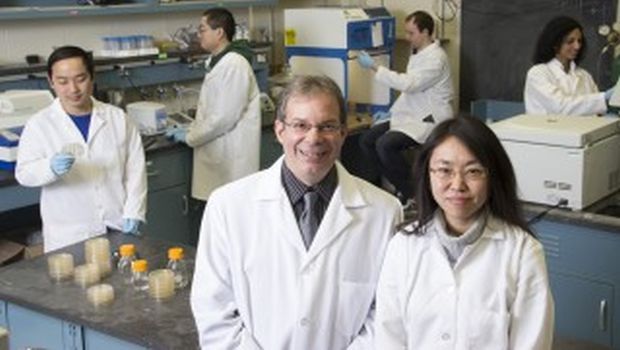Combating Bacterial Infections Through Immunoengineering
The first publication out of a collaboration between Clarkson University and the Trudeau Institute aims to improve the fight against bacterial infections through immunoengineering. Chemical Communications has published a paper authored by researchers at Clarkson University and the Trudeau Institute, titled "Designed Supramolecular Filamentous Peptides: Balance of Nanostructure, Cytotoxicity and Antimicrobial Activity."


Trudeau Institute associate member and Clarkson adjunct associate professor of biology Timothy J. Sellati, front and left, and Clarkson assistant professor of chemistry and biomolecular science He Dong are leading research teams to focus on how to better treat infections through immunoengineering. The research is a collaborative effort between Clarkson University and the Trudeau Institute.
The first publication out of a collaboration between Clarkson University and the Trudeau Institute aims to improve the fight against bacterial infections through immunoengineering. Chemical Communications has published a paper authored by researchers at Clarkson University and the Trudeau Institute, titled "Designed Supramolecular Filamentous Peptides: Balance of Nanostructure, Cytotoxicity and Antimicrobial Activity."
The research teams, led by Clarkson assistant professor of chemistry and biomolecular science He Dong and Trudeau associate member and Clarkson adjunct associate professor of biology Timothy J. Sellati, are focusing on how to better treat infections.
Antimicrobial peptides (AMPs) represent a new antimicrobial therapy to overcome the prevalence of antibiotic-resistance found in conventional antibiotic treatment, Dong says. However, conventional AMPs suffer from structural instability and substantial cytotoxicity, meaning they are toxic to cells. This has dramatically hampered their development, commercialization and application in clinical settings.
The researchers are developing a system to engineer new, stable peptides that will kill bacteria without harming healthy human cells.
“Our work represents a fundamentally new and unique approach to the treatment of antibiotic-resistant bacterial infection by exploiting multiple antimicrobial peptides in the form of Self-Assembled Antimicrobial Nanofibers, which we term as SAANs,” she says. “SAANs demonstrated potent antimicrobial activity, but most importantly showed greatly reduced harm toward healthy human cells. Fundamentally, we're trying to understand the molecular mechanism behind the unique properties of SAANs, and that's going to have a significant impact on practical application of these materials as a new technology for anti-infective therapy development."
Dong said the team is now targeting several types of multi-drug resistant bacterial infections.
"This paper is a good starting point, and there is a lot we can pursue along this pathway," she said. "We're excited, and we're looking down the road to new opportunities."
Sellati said immunoengineering is a marriage of the areas of immunology, which focuses on how healthy bodies function and how they fail to function properly when sick, and engineering, which focuses on the mechanics of how things function. The partnership allows faculty from Clarkson and Trudeau to bring together their unique perspectives and skill sets to solve problems and develop cures.
"It has provided an opportunity for scientists with different experiential backgrounds to get together and develop projects," he says. "For me, the personal benefit has been to move my infectious disease research in a new direction with He Dong, who has expertise in chemistry and materials science and engineering."
Clarkson chemistry doctoral candidates Dawei Xu and Linhai Jiang, Clarkson undergraduate biology student Derek Dustin, and Trudeau postdoctoral fellow Anju Singh worked with Dong and Sellati on the paper. Dong said the partnership between her group and Sellati's group is a valuable training experience for both undergraduate and graduate students.
"A successful collaboration often requires a constant and active communication between groups, and in this partnership it's important to promote the knowledge exchange and discussion between our groups," she says.
Sellati says he enjoys working with the undergraduate students from Clarkson because they bring enthusiasm and new ideas to the table. He has been especially impressed with the research interests and quality of work from the students who participate in the Clarkson Trudeau Biomedical Scholars program.
Students don't usually develop an appreciation for research until later in their academic careers, Sellati says, but the collaboration between Clarkson and Trudeau allows students to preview what it is like to have a career in science and research while they are still undergraduates.
"They now have an opportunity to work more closely with world-renowned research scientists who are working on the cutting edge of immunology and infectious disease," he says.
The Trudeau Institute's fundamental research on immunity fosters the development of vaccines, treatments and cures for many life-threatening diseases, including cancer, tuberculosis and influenza. The Institute is supported by federal and state grants and contributions from individuals, private foundations and corporations.
Source: Clarkson University
Redefining Competency: A Comprehensive Framework for Infection Preventionists
December 19th 2024Explore APIC’s groundbreaking framework for defining and documenting infection preventionist competency. Christine Zirges, DNP, ACNS-BC, CIC, FAPIC, shares insights on advancing professional growth, improving patient safety, and navigating regulatory challenges.
Addressing Post-COVID Challenges: The Urgent Need for Enhanced Hospital Reporting Metrics
December 18th 2024Explore why CMS must expand COVID-19, influenza, and RSV reporting to include hospital-onset infections, health care worker cases, and ER trends, driving proactive prevention and patient safety.
Announcing the 2024 Infection Control Today Educator of the Year: Shahbaz Salehi, MD, MPH, MSHIA
December 17th 2024Shahbaz Salehi, MD, MPH, MSHIA, is the Infection Control Today 2024 Educator of the Year. He is celebrated for his leadership, mentorship, and transformative contributions to infection prevention education and patient safety.
Pula General Hospital Celebrates Clean Hospitals
December 16th 2024Learn how Pula General Hospital in Croatia championed infection prevention and environmental hygiene and celebrated Clean Hospitals Day to honor cleaning staff and promote advanced practices for exceptional patient care and safety.
Understanding NHSN's 2022 Rebaseline Data: Key Updates and Implications for HAI Reporting
December 13th 2024Discover how the NHSN 2022 Rebaseline initiative updates health care-associated infection metrics to align with modern health care trends, enabling improved infection prevention strategies and patient safety outcomes.